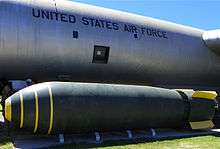Mark 17 nuclear bomb

The Mark 17 and Mark 24 were the first mass-produced hydrogen bombs deployed by the United States. The two differed in their "primary" stages. The MK 17/24 bombs were 24 feet 8 inches (7.52 m) long, 61.4 inches (1.56 m) diameter. They weighed 21 tons. The Mark 17 had a yield in the range of 10 to 15 megatons TNT equivalent. Total production of Mk 17s was 200, and there were 105 Mk 24s produced, all between October 1954 and November 1955.
Design and development originated when Los Alamos National Laboratory proposed that a bomb design using lithium deuteride with non-enriched lithium was possible. The new design was designated TX-17 on February 24, 1953. The TX-17 and 24 were tested as the "Runt" (Castle Romeo shot) device during Operation Castle in 1954. After the successful tests, basic versions of the Mk 17 and 24 were deployed as part of the "Emergency Capability" program. A total of five EC 17 and ten EC 24 bombs were rushed into stockpile between April and October 1954. The EC weapons lacked parachutes to delay the time between release and their detonation, ensuring the delivery aircraft would be destroyed with the target. Other safety features such as In Flight Insertion (IFI) and safe arming and fusing devices were also omitted to ensure a quick thermonuclear capability.
The EC weapons were quickly replaced with Mk 17 Mod 0 and Mk 24 Mod 0 bombs in October and November 1954. Those weapons included a 64-foot-diameter (20 m) parachute to allow the delivery aircraft to escape. With the addition of IFI of the Primary capsule to prevent a nuclear explosion in case of an accident, the weapons were upgraded to the Mod 1 standard. The inclusion of a contact fuze upgraded some bombs to the Mod 2 version, allowing the bombs to be used against "soft" targets (air burst), or buried targets such as command bunkers (contact burst).
Due to the introduction of smaller and lighter weapons such as the Mk 15, as well as the pending retirement of the only aircraft capable of carrying them, the B-36, the Mk 24s were withdrawn by October 1956, with the Mk 17s withdrawn by August 1957.


On May 27, 1957 a Mark 17 was unintentionally jettisoned from a B-36 just south of Albuquerque, NM's Kirtland AFB. The device fell through the closed bomb bay doors of the bomber, which was approaching Kirtland at an altitude of 520 metres (1,700 ft). The device's conventional explosives destroyed it on impact, leaving a crater 7.6 metres (25 ft) in diameter and 3.7 metres (12 ft) deep.[1] Though a chain reaction was impossible because the plutonium pits were stored separately on the plane, the incident spread radioactive contamination and debris over a mile-wide area. Although the military cleaned up the site in secret, a few fragments of the bomb - some radioactive still - may be found in the area.[2]It is one of more than 30 known "Broken Arrow" incidents involving the accidental loss or destruction of a nuclear weapon.
Survivors
Five MK 17/24 casings are on display to the public:
- National Atomic Museum located at Albuquerque, New Mexico.
- The Strategic Air Command Memorial at Naval Air Station Fort Worth Joint Reserve Base at Carswell Field in Fort Worth, Texas.
- The National Museum of the United States Air Force in Dayton, Ohio has a Mk 17/24 casing on display in its Cold War Hangar.
- The Strategic Air and Space Museum in Ashland, Nebraska.
- Castle Air Museum, Atwater, Ca
See also
References
| Wikimedia Commons has media related to Mark 17 nuclear bomb. |
- ↑ "Accident Revealed After 29 Years: H-Bomb Fell Near Albuquerque in 1957". Los Angeles Times. Associated Press. August 27, 1986. Retrieved 31 August 2014.
- ↑ "Center for Land Use Interpretation Places Monument on "Broken Arrow" H-Bomb Impact Site Event Marker Project Continues With Commemoration of Another Peculiar Detonation". Retrieved 19 August 2015.
- Hansen, Chuck. U.S. Nuclear Weapons. Arlington, Texas, Areofax, Inc., 1988. ISBN 0-517-56740-7.
- Gibson, James N. "Nuclear Weapons of the United States," Altglen, PA, Schiffer Publishing, 1996, ISBN 0-7643-0063-6.
- Cochran, Thomas, Arkin, William, Hoenig, Milton "Nuclear Weapons Databook, Volume I, U.S. Nuclear Forces and Capabilities," Cambridge, Massachusetts, Ballinger Pub. Co., 1984, ISBN 0-88410-173-8.
- Hansen, Chuck, "Swords of Armageddon," Sunnyvale, CA, Chucklea Publications, 1995.
